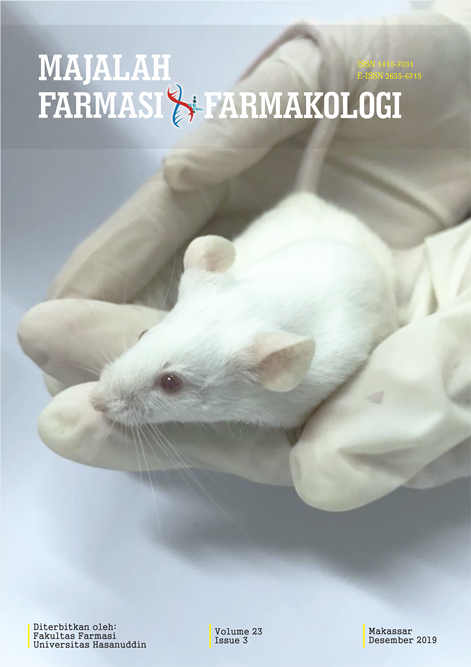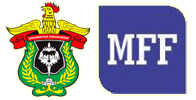EVALUASI HEMATOTOKSIK SECARA IN VITRO NANOPARTIKEL ZnS HASIL REDUKSI BIOMATRIKS Eschericia coli
Abstract
Nanopartikel ZnS merupakan material semi konduktor yang memiliki sifat unik dan manfaat yang besar dibidang kesehatan, terutama sebagai antibakteri dan biomarker kanker. Walaupun demikian, informasi mengenai toksisitas dari nanopartikel ZnS masih sangat terbatas. Oleh karena itu, pada penelitian ini telah dilakukan evaluasi hematotoksisitas secara in vitro nanopartikel ZnS hasil reduksi biomatriks Escherichia coli. Penyiapan nanopartikel ZnS diawali dengan pencampuran dispersi ZnSO4 konsentrasi 200 bpj ke dalam medium Luria Bertani Broth (LBB) yang ditumbuhi E.Coli sebagai bioreduktor. Produk yang dihasilkan dikarakterisasi dengan uji photolimunisence (PL) dan spektrofotometri pada rentang panjang gelombang 250-700 nm. Hasilnya, nanopartikel ZnS berpendar biru dan diidentifikasi pada λmax 288 nm dengan absorbansi 0,905. Partikel yang dihasilkan kemudian didispersikan dengan variasi volume 30 µl, 40 µl, 50 µl pada larutan tyrod. Data persentase hemolisis secara berturut-turut adalah 32%, 39%, 22%, 0% (kontrol negatif) dan 100% (kontrol positif). Sehingga dapat disimpulkan bahwa nanopartikel ZnS hasil reduksi E.coli memberikan efek toksik terhadap sel darah merahReferences
Asha, P., Rajeswari, M. and Bindhu, B. 2016. Zinc sulfide nanoparticles : processing , properties and applications : an overview, Journal of Chemcal and Pharmaceutical Sciences, 9(4), pp. 2047–2052.
Amily Fang-ju jou. dkk. 2015. Diagnosing the mir-141 prostate cancer biomarker using nucleic acid-functiolized cdSe/ZnS Qds and telomerase. Chemical science. 659-665
Sathishkumar, M. et al. 2017. characterization Antimicrobial activity of zinc sulphide nanoparticles and to study their characterization. Reasearch Gate
Durán, N. and Seabra, A. B. 2012. Microbial Syntheses of Metallic Sulfide Nanoparticles : An Overview’, Current Biotechnology, Volume 1 (Juni 2015), pp. 287–296. doi: 10.2174/2211550111201040287.
Dirgantarah, W. 2017. Studi Aplikasi Biomatriks Bakteri Escherichia Coli Pada Produksi Quantum Dots Zink' Skrpsi tidak diterbitkan. Makassar. Fakultas Farmasi Unhas.
Jackson, T. C., Patani, B. O. and Israel, M. B. 2017. Nanomaterials and Cell Interactions : A Review’, Journal of Biomaterials and nanobiotechnology, pp. 220–228. doi: 10.4236/jbnb.2017.84015.
Helle, M. et al. (2012) ‘Visualisation of Sentinel Lymph Node with Indium-Based near Infrared Emitting Quantum Dots in a Murine Metastatic Breast Cancer Model’, PLoS ONE, 7(8). doi: 10.1371/journal.pone.0044433.
Bogutska, К. І., Sklyarov, Y. P. and Prylutskyy, Y. І. 2013 .Zinc and zinc nanoparticles : biological role and application in biomedicine. Ucranica Bioorganica 9–16.
Rijas-Hernandez dkk. 2017. ZnS nanoparticles syhmtesised through chemical aggregation using polyetieneimene that works as boyh stabilizser and complexing agent.
Downloads
Published
Issue
Section
License
The copyright to this article is transferred to Universitas Hasanuddin (UNHAS) if and when the article is accepted for publication. The undersigned hereby transfers all rights in and to the paper including without limitation all copyrights to UNHAS. The undersigned hereby represents and warrants that the paper is original and that he/she is the author of the paper, except for material that is clearly identified as to its original source, with permission notices from the copyright owners where required. The undersigned represents that he/she has the power and authority to make and execute this assignment.
We declare that:
- This paper has not been published in the same form elsewhere.
- It will not be submitted anywhere else for publication prior to acceptance/rejection by this Journal.
- A copyright permission is obtained for materials published elsewhere and which require this permission for reproduction.
Furthermore, I/We hereby transfer the unlimited rights of publication of the above-mentioned paper in whole to UNHAS The copyright transfer covers the exclusive right to reproduce and distribute the article, including reprints, translations, photographic reproductions, microform, electronic form (offline, online) or any other reproductions of similar nature.
The corresponding author signs for and accepts responsibility for releasing this material on behalf of any and all co-authors. This agreement is to be signed by at least one of the authors who have obtained the assent of the co-author(s) where applicable. After submission of this agreement signed by the corresponding author, changes of authorship or in the order of the authors listed will not be accepted.


